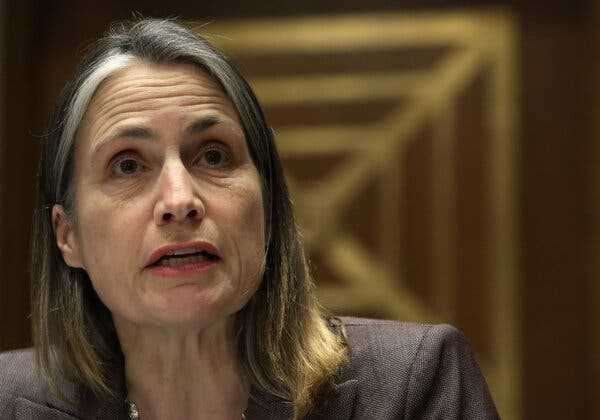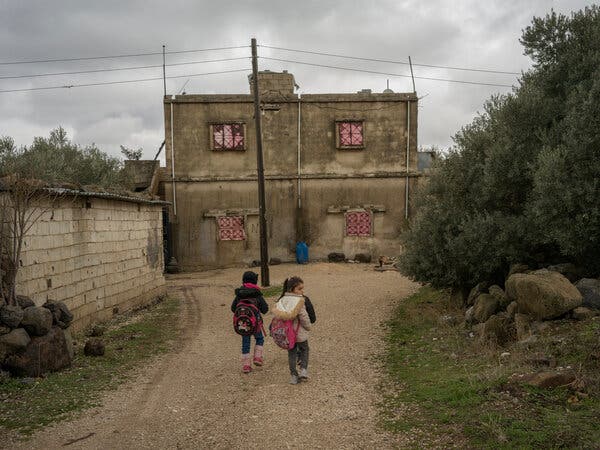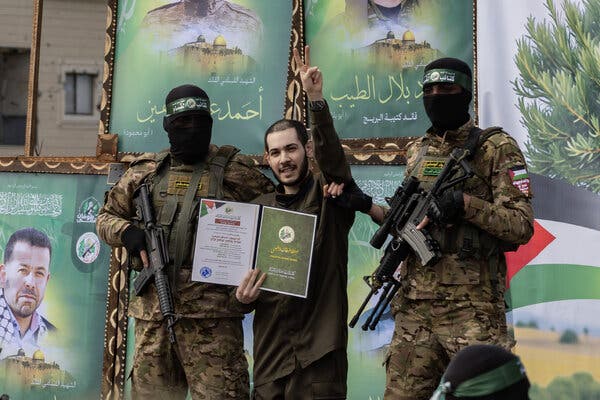We spoke with Fiona Hill, a former Trump adviser, about how the Russian leader’s view of history has led him to the brink of war.

Fiona Hill, an expert on Russia, discussed President Vladimir Putin’s persistent interest in pulling Ukraine into Russia’s orbit.
Winston Churchill once described Russia as “a riddle, wrapped in a mystery, inside an enigma.” It’s a phrase that could equally apply to Vladimir Putin, the Kremlin’s leader, as the world awaits his next move on Ukraine.
To better understand him, we reached out to Fiona Hill, one of Washington’s foremost experts on the Russian president. Hill has served in multiple U.S. administrations as an intelligence officer and policy adviser, most recently as senior director for Europe and Russia on the National Security Council under Donald Trump.
She spoke with us about Putin’s longtime obsession with annexing Ukraine, her worries about how he’s closed himself off from outside information and his private boasts about his ability to “buy anyone” in the United States and Europe.
The following excerpts have been edited for length and clarity:
How would you evaluate the administration’s handling of this crisis so far? What’s worked and what hasn’t?
I think they’re handling it as well as they can be, given the circumstances. Writ large, what the administration is doing right now is certainly what I would recommend doing. But I don’t know whether we can say if it’s going to work or not. The real test is going to be over a long period of time. I don’t think this is going to be a short, sharp crisis.
What do you mean?
Putin’s been trying to get a grip on Ukraine for years now. They cut off the gas to Ukraine in 2006. He’s been in power for 22 years, and the whole of that time, he’s had Ukraine in the cross hairs one way or another, and it’s intensified over time. Putin wants to be the person who, on his watch, in his presidency, pulls Ukraine back into Russia’s orbit. And he could be president until 2036, in terms of what’s possible for him.
Is this fundamentally ideological for him, or geopolitical?
It’s about him personally — his legacy, his view of himself, his view of Russian history. Putin clearly sees himself as a protagonist in Russian history, and is putting himself in the place of previous Russian leaders who’ve tried to gather in what he sees as the Russian land. Ukraine is the outlier, the one that got away that he’s got to bring back.
And does that mean that he’s behaving irrationally here?
No, I don’t think he’s being irrational at all, from his perspective. He’s in a different frame from where we are. He’s living in history and his narrative of history. He also is part of a larger group of security people in Russia who have been opposed to NATO expansion; they want the U.S. out of Europe.
But it seems like he’s made his security situation worse.
That’s from our perspective, on the outside. We don’t know exactly what he’s saying internally. From his point of view right now, he’s put the squeeze on Ukraine and the Ukrainian economy is getting crushed. He’s got all of our attention. We’re all running around doing nothing but talk about him. As he would say, he’s got us listening to him now. Whether we’re hearing him on the terms that he wants us to is another matter.
And you think he’s willing to pay a very high price to get Ukraine — that he’s willing to bear costs that we would see as exorbitant?
Putin thinks that he can be more aggressive and wait us out and take more pain than we can. His goal is to make us split apart, to basically capitulate without actually doing anything. So he’s going to keep the pressure up. I can’t say whether he’s going to invade. But he’s certainly going to give us every impression that he’s going to do it, and he wants to try to find operational surprise. He wants to catch us out.
ImageA Ukrainian military tank exercise was abruptly canceled Thursday in Donetsk Oblast in eastern Ukraine, as soldiers prepared to move to an undisclosed location.Credit…Tyler Hicks/The New York Times
When he looks at the West’s response, how do you think he is reading the signals?
I don’t know what signals he’s actually getting directly, beyond what they give him in media compilations, what he might be listening to. And that’s part of the problem. We don’t know how good his intel is. And in some cases, we think it might not be great, because he certainly hasn’t read the mood in Ukraine as well as you might have thought. He obviously thought that we’d all fall apart internationally. He didn’t probably anticipate the Western resolve that he’s got in the form of NATO and European unity, but we don’t know what people are telling him.
People may be spinning to him that he’s done a great job — you know, that we’re all capitulating. He’s got a parade of European leaders coming and he’s trying to test them and see what they have to say. He’s looking for daylight between them, and then he’s making his own assessment.
Live Updates: Russia-Ukraine Tensions
Updated Feb. 18, 2022, 7:26 p.m. ET
- Videos show reported explosions near Luhansk.
- What videos reveal about tensions in Eastern Ukraine.
- Multinationals in Ukraine are ready for a conflict but staying put.
Do you think the United States needs to squeeze Putin harder? To impose punishments now rather than waiting for some trigger to set off another round of sanctions?
That would be a mistake, to trigger off right now. It doesn’t work with just such crude messaging. You have to be able to show the cause and effect of sanctions when you put them on and off. Otherwise, the view then becomes, well, there’s nothing we can do anyway. Because the Russian point of view is that all the U.S. does is put sanctions on countries irrespective of what they do. We would just feed that narrative.
And we already are doing plenty of things. But if we put unilateral sanctions on, in advance of more action from Russia, we’ll have lost the allies. And Putin probably is banking on some of that.
Last night, I was at dinner with a European foreign minister and one of their under secretaries. And they were relating discussions that they’ve had with the Russians, where Putin’s told them bluntly that they can buy anyone they like in the United States or in Europe.
The Russians think that they can just outmaneuver the United States and all of the allies on sanctions and everything else. And they’ve been very successful at that, because they have lobbyists within our own systems who lobby for them. You can go down a long list of people who are on the board of Russian companies or do consulting for Russian companies.
Understand the Escalating Tensions Over Ukraine
Card 1 of 5
A brewing conflict. Antagonism between Ukraine and Russia has been simmering since 2014, when the Russian military crossed into Ukrainian territory, annexing Crimea and whipping up a rebellion in the east. A tenuous cease-fire was reached in 2015, but peace has been elusive.
A spike in hostilities. Russia has been gradually building up forces near its border with Ukraine, and the Kremlin’s messaging toward its neighbor has hardened. Concern grew in late October, when Ukraine used an armed drone to attack a howitzer operated by Russian-backed separatists.
Preventing an invasion. Russia called the strike a destabilizing act that violated the cease-fire agreement, raising fears of a new intervention in Ukraine. Since then, the United States, NATO and Russia have been engaged in a whirlwind of diplomacy aimed at averting that outcome.
The Kremlin’s position. President Vladimir V. Putin of Russia, who has increasingly portrayed NATO’s eastward expansion as an existential threat to his country, said that Moscow’s growing military presence on the Ukrainian border was a response to Ukraine’s deepening partnership with the alliance.
Rising tension. Western countries have tried to maintain a dialogue with Moscow. But the Biden administration warned that the U.S. could throw its weight behind Ukraine in case of an invasion. France, Germany and Poland also warned Russia of consequences if it launched incursions into Ukraine.
Clearly, it’s always been for political leverage. And Putin explicitly says: I can buy anyone. I don’t, by the way, believe that he can, because I do know people who work with the Russians and maintain their integrity. But from Putin’s point of view, that’s very strong signaling.
You’ve sat it on meetings with Putin. Does he just kind of rant about his view of history?
He has his own rationality, and, in the past, he’s been much more measured. But I know a lot of people who’ve been through Moscow recently, and they’re saying the guy seems even more closed off to the news. We’re not really sure what kind of information he’s getting, and he seems more embittered. And is it the effect of Covid? Is it because he’s been stewing in his own juices for too long? We can’t really be sure what exactly he is thinking right now. You’ve got to hope that some saner voices are forcing a recalculation.
ImageImageSt. Louis County Prosecutor Wesley Bell, center, with police officials before a news conference about an officer who was shot and killed in 2019.Credit…Robert Cohen/St. Louis Post-Dispatch, via Associated Press
What to read
-
Progressive prosecutors hoping to roll back tough-on-crime measures are facing resistance as violent crime rates grow in some cities, Astead W. Herndon reports.
-
Representative Kevin McCarthy, the House Republican leader, endorsed Harriet Hageman, a pro-Trump candidate and primary challenger to Representative Liz Cheney. Annie Karni writes that the endorsement “was an extraordinary move” for McCarthy, who “has worked to toe a fine line between his far right flank and more mainstream conservatives.”
-
The National Archives found that documents Donald Trump took home to Florida included classified information, report Luke Broadwater and Michael S. Schmidt. The letter from the archives also said “some White House staff conducted official business using nonofficial electronic messaging accounts.”
Image
viewfinder
ImageThe first lady, Jill Biden, walking with children from Aiton Elementary School in Washington on Monday.Credit…Al Drago for The New York Times
Valentine’s visitors at the White House
On Politics regularly features work by Times photographers. On Valentine’s Day on Monday, Jill Biden led second-grade students from Aiton Elementary School in Washington on a tour of the White House. Here’s what Al Drago told us about capturing the image above:
I could hear students cheering as their mini yellow school bus pulled up the driveway on the South Lawn. The first lady’s presence was a surprise, and when I saw her walking with the students, they were jumping up and down and holding hands with her.
I like this photo because you can see how eager the students are to keep moving, as the girl in front pulls her classmate forward. The students toured the North Lawn, Cross Hall, the White House movie theater, and more. Biden, a longtime advocate for educators who continues to teach at Northern Virginia Community College, apologized to the visiting teacher for giving her students chocolate that could make them hyper later in the day.
I captured this photo as Biden was walking in between preplanned photo ops. Especially in covering politics, I am always looking for those more human, in-between moments.
Image
Is there anything you think we’re missing? Anything you want to see more of? We’d love to hear from you. Email us at [email protected].
Source: nytimes.com



